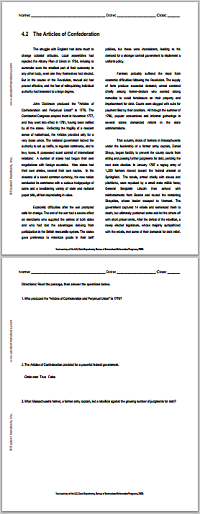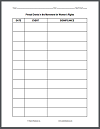| The Articles of Confederation Reading with Questions |
|---|
| www.studenthandouts.com ↣ American History ↣ American History Readings with Questions |
 The struggle with England had done much to change colonial attitudes. Local assemblies had rejected the Albany Plan of Union in 1754, refusing to surrender even the smallest part of their autonomy to any other body, even one they themselves had elected. But in the course of the Revolution, mutual aid had proved effective, and the fear of relinquishing individual authority had lessened to a large degree.
The struggle with England had done much to change colonial attitudes. Local assemblies had rejected the Albany Plan of Union in 1754, refusing to surrender even the smallest part of their autonomy to any other body, even one they themselves had elected. But in the course of the Revolution, mutual aid had proved effective, and the fear of relinquishing individual authority had lessened to a large degree.John Dickinson produced the "Articles of Confederation and Perpetual Union" in 1776. The Continental Congress adopted them in November 1777, and they went into effect in 1781, having been ratified by all the states. Reflecting the fragility of a nascent sense of nationhood, the Articles provided only for a very loose union. The national government lacked the authority to set up tariffs, to regulate commerce, and to levy taxes. It possessed scant control of international relations: A number of states had begun their own negotiations with foreign countries. Nine states had their own armies, several their own navies. In the absence of a sound common currency, the new nation conducted its commerce with a curious hodgepodge of coins and a bewildering variety of state and national paper bills, all fast depreciating in value. Economic difficulties after the war prompted calls for change. The end of the war had a severe effect on merchants who supplied the armies of both sides and who had lost the advantages deriving from participation in the British mercantile system. The states gave preference to American goods in their tariff policies, but these were inconsistent, leading to the demand for a stronger central government to implement a uniform policy. Farmers probably suffered the most from economic difficulties following the Revolution. The supply of farm produce exceeded demand; unrest centered chiefly among farmer-debtors who wanted strong remedies to avoid foreclosure on their property and imprisonment for debt. Courts were clogged with suits for payment filed by their creditors. All through the summer of 1786, popular conventions and informal gatherings in several states demanded reform in the state administrations. That autumn, mobs of farmers in Massachusetts under the leadership of a former army captain, Daniel Shays, began forcibly to prevent the county courts from sitting and passing further judgments for debt, pending the next state election. In January 1787 a ragtag army of 1,200 farmers moved toward the federal arsenal at Springfield. The rebels, armed chiefly with staves and pitchforks, were repulsed by a small state militia force; General Benjamin Lincoln then arrived with reinforcements from Boston and routed the remaining Shaysites, whose leader escaped to Vermont. The government captured 14 rebels and sentenced them to death, but ultimately pardoned some and let the others off with short prison terms. After the defeat of the rebellion, a newly elected legislature, whose majority sympathized with the rebels, met some of their demands for debt relief. Directions: Read the text above, then answer the questions below. 1. Who produced the “Articles of Confederation and Perpetual Union” in 1776? John Dickinson 2. The Articles of Confederation provided for a powerful federal government. False 3. What Massachusetts farmer, a former army captain, led a rebellion against the growing number of judgments for debt? Daniel Shays Click here to print. |
 |  |  |  |  |  |
| www.studenthandouts.com ↣ American History ↣ American History Readings with Questions |








